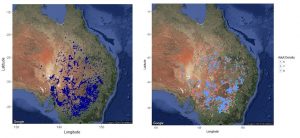
Douglas Lawton, Global Locust Initiative member and Arizona State University doctoral student, is spending the summer in Australia. Douglas studies landscape variables that affect the behavior of Australian plague locusts, and is co-advised by Arianne Cease, GLI Founding Director and ASU Assistant Professor, and Cathy Waters, a Rangelands Research Officer at the New South Wales Department of Primary Industries.
Lawton sent us the following update, along with preliminary maps he developed this summer:
"The Australian plague locust (Chortoicetes terminifera) is the most important Orthopteran pest in Australia. However, our knowledge on the types of habitat and corresponding environmental variables that lead to their swarms remains limited. Using a 30-year data set of Australian plague locust abundances throughout eastern Australia, I am building a heat map of favorable Australian plague locust habitats.
"My first focus is on what static (with respect to locust ecology — e.g. soil characteristics) environmental variables are favorable for their population amplification. I am collaborating with the Australian Plague Locust Commission (APLC) and with several modelers in the NSW DPI’s climate unit to build an artificial neural network on the spatial and temporal variables that have led to locust swarms in the past, with the possibility of swarm prediction going into the future. This project will ultimately aid in Australian locust management efforts and inform the APLC forecasters about the effects of climate change on the four locust species of Australia."

Are you a GLI member with updates from the field? Please send any info to locust[at]asu.edu! Not a member? Join the GLI!
Top photo: Douglas Lawton, pictured in Australia with his co-advisor, Dr. Cathy Waters of New South Wales Department of Primary Industries